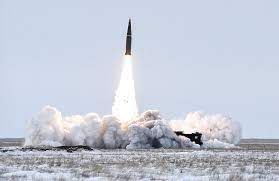UPSC Daily Current Affairs- 28th March 2023 | Current Affairs & Hindu Analysis: Daily, Weekly & Monthly PDF Download
GS-I
Depleted Uranium

Why in News?
Recently, UK committed to provide weapons containing depleted uranium to Ukraine.
About Depleted Uranium:-
- It is a by-product of the process of creating enriched uranium, which is used in nuclear reactors and nuclear weapons.
- In comparison to enriched uranium, depleted uranium is much less radioactive.
- It is incapable of generating a nuclear reaction.
- It is denser than lead.
- It is thus ,widely used in weapons as it can easily penetrate armour plating.
- Apart from the US, Britain, Russia, China, France and Pakistan produce uranium weapons.
- These are not classified as nuclear weapons, as per the International Coalition to Ban Uranium Weapons.
- the International Coalition to Ban Uranium Weapons(ICBUW):-
- It coordinates campaigning against Depleted Uranium ammunition worldwide within the framework of the United Nations.
- In particular, the campaign is supported by the IPPNW (International Doctors for the Prevention of Nuclear War) and the IALANA (Lawyers Against Atomic, Biological and Chemical Weapons).
- It was established in 2003 in Berlaar, Belgium.
- It has had special consultative status with the UN Economic and Social Council (ECOSOC) since 2005.
- The Coalition provides the framework for dealing with all aspects of the uranium weapons issue and seeks to bring peace, human rights and environmental movements closer together on this issue.
- The aim of the coalition is to ban DU weapons, eliminate the environmental damage caused by uranium weapons use, help the victims, and prevent future damage from such weapons and actions.
- The coalition is open to NGOs, groups and individuals who wish to contribute to the realization of their goals.
- Ingesting or inhaling them depresses renal function and raises the risk of developing a range of cancers.
- Depleted uranium munitions which miss their target can poison groundwater and soil.
Source: Indian Express
CRISP App

Why in News?
Recently, the Rubber Board has launched a mobile app CRISP to inform growers about rubber cultivation and provides solutions online.
About CRISP App:
- The Comprehensive Rubber Information System Platform (CRISP) application has been developed by the Rubber Research Institute of India (RRII) in collaboration with the Digital University of Kerala.
- It gives information to rubber cultivators related to production and productivity enhancement, reduction of cultivation cost, maintenance of soil fertility, disease control measures, etc.
Key facts about Rubber Plantations in India
- Natural rubber is a polymer made up of a chemical molecule called isoprene.
- It is a native of the Amazon basin which was introduced to countries in the tropical belts of Asia and Africa in the late nineteenth century.
- Climatic conditions required for Rubber
- Rainfall: It requires moist and humid climates with heavy rainfall of more than 200 cm.
- Temperature: It grows well in equatorial climates and temperatures above 25 degrees Celsius.
- Soil: Well-drained, weathered soils.
- India is the world’s largest producer and the third-largest user of natural rubber.
- Rubber Growing Areas in India
- Traditional Areas: Primarily in Tamil Nadu’s Kanyakumari District and Kerala.
- Non-traditional regions: Coastal Karnataka, Goa, Maharashtra’s Konkan Region, coastal Andhra Pradesh and Orissa, the northeastern provinces, and the Andaman and Nicobar Islands, among other places.
Source: The Hindu
GS-II
Status of Smart Cities Mission
Why in News?
Minister of State for Housing and Urban Affairs recently informed Lok Sabha that the implementation period of the Smart City Mission had been extended upto June 2023.
About Smart Cities Mission (SCM):
- It is a Centrally Sponsored Scheme launched in 2015.
- It will cover 100 cities and is being implemented by the Ministry Housing and Urban Affairs and all state and union territory (UT) governments.
- It initially aimed to be completed by 2019-20 but has since been extended.
- The projects were supposed to be completed within five years of the selection of the city, but in 2021 the Ministry changed the deadline for all cities to June 2023.
- As of March 2023, the 100 cities have issued work orders for 7,799 projects. Out of these, 5,399 projects have been completed, and the rest are ongoing.
- Only around 20 cities are likely to meet the June deadline; the rest will need more time.
Significance:
- India is the world’s second-most populous nation.
- 31% of India’s present population and contribute around 63% of GDP (Census 2011).
- Urban areas are anticipated to house 40% of India’s people and contribute around 75% of India’s GDP by the year 2030.
- To promote cities that provide core infrastructure and give a decent quality of life to their citizens, a clean and sustainable environment and application of ‘Smart’ Solutions.
- Make Cities liveable, inclusive, sustainable (Area-based development).
- Create employment opportunities.
- Integrated Command and Control Centres:
- All 100 cities have also constructed Integrated Command and Control Centres to monitor all security, emergency and civic services.
- During the peak of the Covid-19 pandemic, these centres were converted into emergency response units by many of the cities.
Challenges
Infrastructure development:
- A lot of challenges come up when a large scale infrastructure development is done.
- The legal set-up, inconsistency in policies and regulatory norms are the major challenges in a country like India. They affect the actual execution of projects.
Financing for project:
- Keeping the funds and finances flowing in for the smart cities mission is a challenge. Most ULBs are not even financially self-sustainable.
- Getting the right finances flowing in for the completion of the project and later the maintenance of the technological developments in the smart cities can be a challenge.
Technical constraints:
- Most of the urban local bodies have a limited technical capacity to ensure the development of the smart cities.
- These technical and technological limitations hinder the cost-effective and timely implementation of the smart steps.
Transport:
- Urbanizing the public transport for urban mobility is a challenge for the government due to the inadequate transport system currently persisting in the cities.
- Various factors like lack of investment, high population density, zoning, and poor urban planning have been making the transit system in Indian cities inadequate.
Government Initiatives to Support the SCM
- National Urban Digital Mission (NUDM): It will create a shared digital infrastructure for urban India.
- It shall work across the three pillars of people, process, and platform to provide complete support to cities and towns.
- National Urban Learning Platform (NULP): It aims to propagate solutions and innovations that are underway, and act as an enabler of the rapid development of diverse new solutions developed by cities and states.
- Ease of Living Index (EoLI): The EoLI is an assessment tool by the Ministry of Housing and Urban Affairs that evaluates the quality of life and the impact of various initiatives for urban development in the city.
- India Smart Cities Awards Contest (ISAC): It was launched to reward the cities, projects and innovative ideas promoting ‘smart; development in cities.
- The Urban Learning Internship Programme (TULIP): TULIP is a program for providing fresh graduates with experiential learning opportunities in the urban sector.
- It would help enhance the value-to-market of India’s graduates and help create a potential talent pool in diverse fields like urban planning, transport engineering, environment, municipal finance etc.
Way Forward:
As India continues its growth trajectory, the quality of its urbanisation will become paramount to ensure that this growth is sustainable and equitable. It is imperative that the government finds a solution to overcome these challenges to see the dream project of turning more than 100 Indian cities into smart cities.
There has indeed been progress on a wide variety of smart projects in the 100 cities and towns chosen under the Smart Cities Mission. The completed projects are providing social and economic benefits, especially to the marginalised sections of the populations of these cities.
Source: Indian Express
What is the principle of Audi Alteram Partem?
Why in News?
The Supreme Court recently held that the principles of "audi alteram partem" must be read into the circular issued by the Reserve Bank of India on the classification of bank accounts as fraud accounts.
About Audi Alteram Partem:
- The literal meaning of Audi Alteram Partem is to “hear the other side”.
- It denotes that every party shall get an opportunity of hearing and no one shall go unheard in a case.
- Under this doctrine, every party shall get an opportunity to plead and assert evidence to support his case.
- This ensures a fair hearing and fair justice to both the parties.
- No decision can be declared without hearing both the parties. The aim of this principle is to give an opportunity to both the parties to defend themselves.
- The doctrine is the basic concept of the principle of natural justice.
- The following are the key components of this doctrine:
- Notice:
- Before any action is taken, the affected party must be given a notice to show cause against the proposed action and seek his explanation.
- A notice must contain the time, place and date of hearing, jurisdiction under which the case is filed, the charges, and proposed action against the person.
- Any order passed without giving notice is against the principles of natural justice and is void.
- Hearing:
- The order passed by the authority without providing the reasonable opportunity of being heard to the person affected by it adversely will be invalid and must be set aside.
- Evidence:
- It is an important part which is to be brought properly before the Court in the presence of both the parties and a judicial or quasi judicial authority must have to act on the evidence produced as in the case.
- Cross-Examination:
- Every person has the right to contest or object to the evidence presented by the other party.
- Legal Representation:
- Every person is not able to present his case assertively. Thus, he needs some assistance from a specialised legal attorney to present his case.
- The Indian Constitution also provides that every person has a right to get legal assistance.
- Exceptions to the doctrine of Audi Alteram Partem:
- The word exception doesn’t mean the principles of natural justice and fair play will not be there.
- These exceptions only denote those conditions in which nothing unfair will occur, even if certain conditions of this maxim are relaxed.
- Some conditions for exceptions are:
- Emergency;
- Confidentiality;
- Impractibility;
- Statutory Exclusion;
- Legislative Function
Source: Indian Express
GS-III
Sanjay Gandhi National Park

Why in News?
Recently, four tiger cubs were born in Mumbai’s Sanjay Gandhi National Park after 13 years.
About Sanjay Gandhi National Park:-
- It is a protected area near Mumbai in Maharashtra.
- It was formerly known as Borivali National Park.
- It was renamed to its present name in 1996, after Sanjay Gandhi.
- Sanjay Gandhi: he was the eldest son of former Prime Minister Indira Gandhi.
- It is part of the Western Ghats’ biodiversity.
- It forms roughly 20.5% of Mumbai’s geographical area.
- Kanheri Caves is situated within a national park
- It is a 2000-year-old complex of some 160 rock-cut caves.
- It was an important Buddhist learning centre
- It is a protected archaeological site.
- The name Kanheri is derived from ‘Kanhagiri’ in Prakrit .
- It occurs in the Nasik inscription of the Satavahana ruler Vasisthiputra Pulumavi.
- Kanheri was mentioned in the travelogues of foreign travellers.
- The earliest reference of Kanheri is ascribed to Fa-Hein who visited India during 399-411 CE and later by several other travelers.
- These excavations were primarily undertaken during the Hinayana phase of Buddhism but also has several examples of the Mahayana stylistic architecture as well as few printings of the Vajrayana order.
SOURCE: THE INDIAN EXPRESS
What are Tactical Nuclear Weapons?
Why in News?
Russian President Vladimir Putin recently said he would deploy tactical nuclear weapons in neighbouring Belarus.
About Tactical Nuclear Weapons:
- Nuclear weapons, just like other weapons, can be categorised into two types — strategic and tactical.
- Strategic Nuclear Weapons: They refer to nuclear weapons that have bigger objectives, such as destroying cities or larger targets, with larger war-waging objectives in mind.
- Tactical Nuclear Weapons (TNWs):
- They are nuclear weapons used for specific tactical gains on the battlefield.
- They are intended to devastate enemy targets in a specific area without causing widespread destruction and radioactive fallout.
- These are designed for use in battle as part of an attack with conventional weapon forces.
- These warheads can be delivered via a variety of missiles, torpedoes and gravity bombs from naval, air or ground forces. They could even be simply driven into an area and detonated.
- The explosive yield of tactical nuclear weapons can range from under one kiloton to about 100 kilotons, whereas strategic nuclear weapons can have a yield of up to one thousand kilotons.
- Delivery systems for tactical nuclear weapons also tend to have shorter ranges, typically under 310 miles (500 kilometres), compared with strategic nuclear weapons, which are typically designed to cross continents.
- They are the least-regulated category of nuclear weapons covered in arms control agreements.
- Countries possessing TNWs:
- Nine countries have tactical nuclear weapons, according to the Federation of American Scientists.
- They are Russia, the United States, China, France, the United Kingdom, Pakistan, India, Israel and North Korea.
- Russia has a stockpile of an estimated 2,000 tactical nuclear missiles.
- The U.S. has an estimated 200 tactical nuclear bombs, half of which are at bases in Europe.
Source: The Hindu
What is an Index Provider?
Why in News?
The Central Government recently put the onus of regulating the practices of market index providers on the Securities Exchange Board of India (SEBI).
About Index Provider:
- Index providers are those institutions that formulate and manage indices.
- One of the important roles of the index provider is to classify and define markets, as their indices represent a market or a proportion of a market and provide a benchmark of performance for that market or sector.
- They have the responsibility to set the rules that decide what securities to include in each index, how the index will be managed and how securities will be added or removed from that index over time.
- They also usually determine how stocks can be classified, e.g. is a particular stock a Healthcare or an Oil & Gas stock, or is it a Developed or Emerging market stock.
- An index allows investors and other stakeholders to get a snapshot of the market.
- S&P Dow Jones, MSCI, and Bloomberg are some of the globally renowned institutions that provide indices.
- In India, this activity is generally carried out by subsidiaries of stock exchanges. The most prominent indices in India are the Nifty50 by NSE Indices and Sensex provided by a venture of S&P Dow Jones Indices and BSE Lied.
Source: The Hindu
|
38 videos|5288 docs|1117 tests
|
FAQs on UPSC Daily Current Affairs- 28th March 2023 - Current Affairs & Hindu Analysis: Daily, Weekly & Monthly
| 1. What is the significance of GS-I, GS-II, and GS-III in UPSC exams? |  |
| 2. How can I prepare for GS-I in the UPSC exams? |  |
| 3. What topics are covered in GS-II of the UPSC exams? |  |
| 4. How can I improve my performance in GS-III of the UPSC exams? |  |
| 5. Are there any specific strategies to effectively manage time during the UPSC exams for GS-I, GS-II, and GS-III? |  |

























